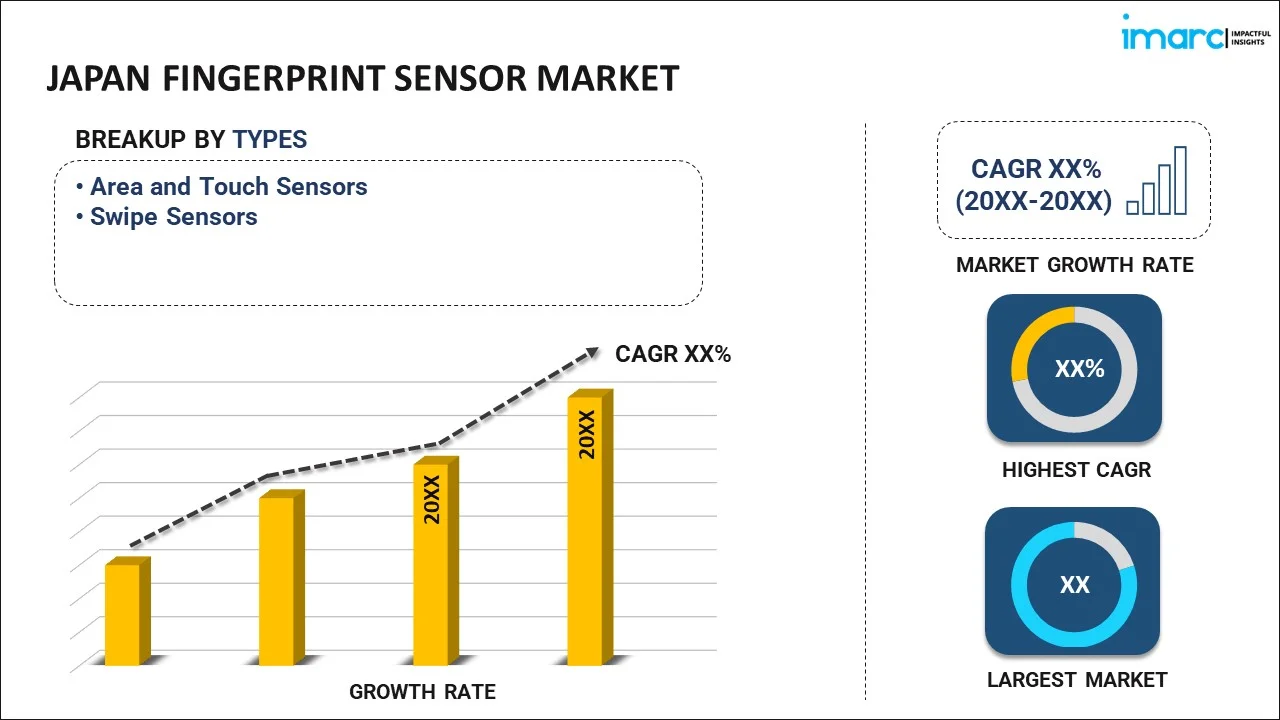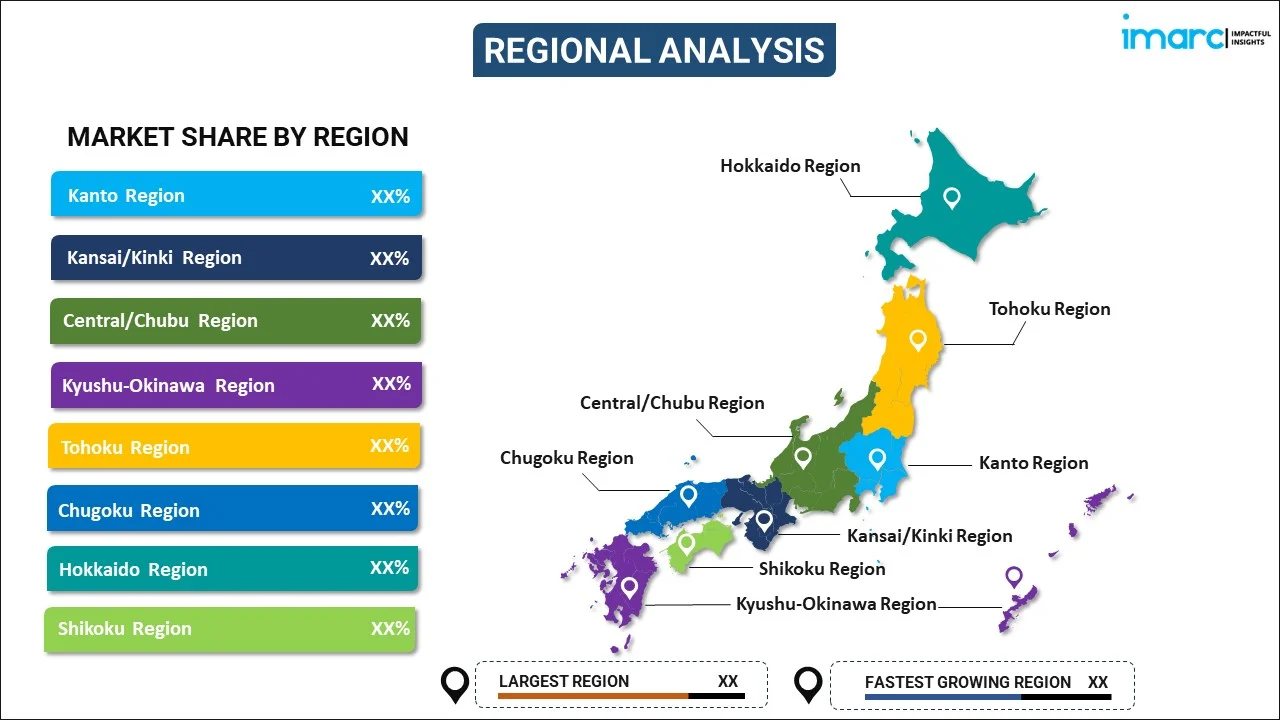
Japan Fingerprint Sensor Market Report by Type (Area and Touch Sensors, Swipe Sensors), Technology (Capacitive, Optical, Thermal, and Others), Application (Consumer Electronics, Government and Law Enforcement, Military, Defense and Aerospace, Travel and Immigration, Banking and Finance, Healthcare, Smart Homes, and Others), and Region 2025-2033
Market Overview:
Japan fingerprint sensor market size reached USD 455.0 Million in 2024. Looking forward, IMARC Group expects the market to reach USD 1,091.0 Million by 2033, exhibiting a growth rate (CAGR) of 10.20% during 2025-2033. The growing awareness about maintaining data privacy, increasing preferences for contactless payments and transactions, and rising need for enhanced security solutions to secure access of patient records in healthcare facilities represent some of the key factors driving the market.
|
Report Attribute
|
Key Statistics
|
|---|---|
|
Base Year
|
2024 |
|
Forecast Years
|
2025-2033
|
|
Historical Years
|
2019-2024
|
| Market Size in 2024 | USD 455.0 Million |
| Market Forecast in 2033 | USD 1,091.0 Million |
| Market Growth Rate (2025-2033) | 10.20% |
A fingerprint sensor, also known as a biometric sensor, is an advanced electronic device that captures and analyzes unique fingerprint patterns for the purpose of identity verification and authentication. It operates on the principle that every person has a distinct set of ridges, loops, and whorls on their fingertips, making fingerprints highly individual and virtually impossible to replicate accurately. It works by scanning the fingerprint of an individual and converting the unique pattern into a digital code or template, which is then compared to stored templates for authentication. It plays a pivotal role in safeguarding sensitive data, securing access to electronic devices, and providing a seamless user experience. It ensures that only authorized users can unlock and access sensitive information. It provides secure and convenient authentication for financial transactions and prevents financial fraud. It assists in enhancing security and streamlining authentication processes in numerous settings. It aids in simplifying the management of permissions and access rights and lowering the hassle of remembering passwords or carrying access cards. As it is beneficial in reducing the risk of unauthorized access to devices, systems, and premises and minimizing the chances of data breaches or security breaches, the demand for fingerprint sensor is increasing in Japan.
Japan Fingerprint Sensor Market Trends:
At present, the growing demand for fingerprint sensors to gain entry to secure areas or buildings instead of using traditional keys or access cards represents one of the major factors contributing to the market growth in Japan. Moreover, the rising adoption of fingerprint sensors in workforce management for tracking time and attendance of employees is strengthening the growth of the market in the country. Apart from this, the escalating demand for fingerprint sensors in passport and immigration systems for identifying verification and improving national security is offering a positive market outlook. Additionally, the increasing need for enhanced security solutions to secure access to patient records in healthcare facilities is providing lucrative growth opportunities to industry investors operating in the country. In line with this, the rising employment of fingerprint sensors in smartphones for device unlocking and secure mobile payments is impelling the market growth in Japan. In addition, increasing preferences for contactless payments and transactions are bolstering the growth of the market. Besides this, the rising installation of fingerprint-based access control systems in data centers is propelling the market growth in Japan. Furthermore, the growing demand for fingerprint sensors in automobiles for vehicle security and safety is influencing the market positively in the country.
Japan Fingerprint Sensor Market Segmentation:
IMARC Group provides an analysis of the key trends in each segment of the market, along with forecasts at the country level for 2025-2033. Our report has categorized the market based on type, technology, and application.
Type Insights:

- Area and Touch Sensors
- Swipe Sensors
The report has provided a detailed breakup and analysis of the market based on the type. This includes area and touch sensors and swipe sensors.
Technology Insights:
- Capacitive
- Optical
- Thermal
- Others
A detailed breakup and analysis of the market based on the technology have also been provided in the report. This includes capacitive, optical, thermal, and others.
Application Insights:
- Consumer Electronics
- Government and Law Enforcement
- Military, Defense and Aerospace
- Travel and Immigration
- Banking and Finance
- Healthcare
- Smart Homes
- Others
The report has provided a detailed breakup and analysis of the market based on the application. This includes consumer electronics, government and law enforcement, military, defense and aerospace, travel and immigration, banking and finance, healthcare, smart homes, and others.
Regional Insights:

- Kanto Region
- Kansai/Kinki Region
- Central/ Chubu Region
- Kyushu-Okinawa Region
- Tohoku Region
- Chugoku Region
- Hokkaido Region
- Shikoku Region
The report has also provided a comprehensive analysis of all the major regional markets, which include Kanto Region, Kansai/Kinki Region, Central/ Chubu Region, Kyushu-Okinawa Region, Tohoku Region, Chugoku Region, Hokkaido Region, and Shikoku Region.
Competitive Landscape:
The market research report has also provided a comprehensive analysis of the competitive landscape. Competitive analysis such as market structure, key player positioning, top winning strategies, competitive dashboard, and company evaluation quadrant has been covered in the report. Also, detailed profiles of all major companies have been provided.
Japan Fingerprint Sensor Market Report Coverage:
| Report Features | Details |
|---|---|
| Base Year of the Analysis | 2024 |
| Historical Period | 2019-2024 |
| Forecast Period | 2025-2033 |
| Units | Million USD |
| Scope of the Report | Exploration of Historical Trends and Market Outlook, Industry Catalysts and Challenges, Segment-Wise Historical and Future Market Assessment:
|
| Types Covered | Area and Touch Sensors, Swipe Sensors |
| Technologies Covered | Capacitive, Optical, Thermal, Others |
| Applications Covered | Consumer Electronics, Government and Law Enforcement, Military, Defense and Aerospace, Travel and Immigration, Banking and Finance, Healthcare, Smart Homes, Others |
| Regions Covered | Kanto Region, Kansai/Kinki Region, Central/ Chubu Region, Kyushu-Okinawa Region, Tohoku Region, Chugoku Region, Hokkaido Region, Shikoku Region |
| Customization Scope | 10% Free Customization |
| Post-Sale Analyst Support | 10-12 Weeks |
| Delivery Format | PDF and Excel through Email (We can also provide the editable version of the report in PPT/Word format on special request) |
Key Questions Answered in This Report:
- How has the Japan fingerprint sensor market performed so far and how will it perform in the coming years?
- What has been the impact of COVID-19 on the Japan fingerprint sensor market?
- What is the breakup of the Japan fingerprint sensor market on the basis of type?
- What is the breakup of the Japan fingerprint sensor market on the basis of technology?
- What is the breakup of the Japan fingerprint sensor market on the basis of application?
- What are the various stages in the value chain of the Japan fingerprint sensor market?
- What are the key driving factors and challenges in the Japan fingerprint sensor?
- What is the structure of the Japan fingerprint sensor market and who are the key players?
- What is the degree of competition in the Japan fingerprint sensor market?
Key Benefits for Stakeholders:
- IMARC’s industry report offers a comprehensive quantitative analysis of various market segments, historical and current market trends, market forecasts, and dynamics of the Japan fingerprint sensor market from 2019-2033.
- The research report provides the latest information on the market drivers, challenges, and opportunities in the Japan fingerprint sensor market.
- Porter's five forces analysis assist stakeholders in assessing the impact of new entrants, competitive rivalry, supplier power, buyer power, and the threat of substitution. It helps stakeholders to analyze the level of competition within the Japan fingerprint sensor industry and its attractiveness.
- Competitive landscape allows stakeholders to understand their competitive environment and provides an insight into the current positions of key players in the market.
Need more help?
- Speak to our experienced analysts for insights on the current market scenarios.
- Include additional segments and countries to customize the report as per your requirement.
- Gain an unparalleled competitive advantage in your domain by understanding how to utilize the report and positively impacting your operations and revenue.
- For further assistance, please connect with our analysts.
 Inquire Before Buying
Inquire Before Buying
 Speak to an Analyst
Speak to an Analyst
 Request Brochure
Request Brochure
 Request Customization
Request Customization




.webp)




.webp)












